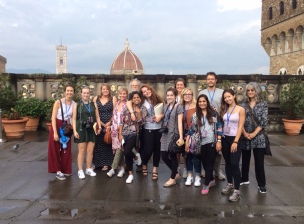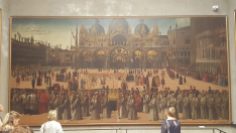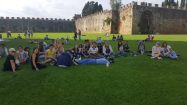Which Ancient Philosopher Are You?
31, December 2019 § 2 Comments
Epicureanism. Living gracefully within the garden of nature.
The Aegean Center students and staff spend a month each fall living and studying in the Villa Rospigloisi, in Pistoia, Italy. Besides classes in drawing and photography, we learn about Renaissance art and travel most days to see masterworks, returning with gratitude each evening to our villa in the hills. We often linger in the garden in the hours before dinner, watching the light play over the 400 year old magnolia trees, listening to the fountain splash and enjoying the aroma of food coming from the kitchen. We have few distractions, plenty of time to converse, and delicious home cooked meals. The combination of study and simple living create a joyous and rewarding month.
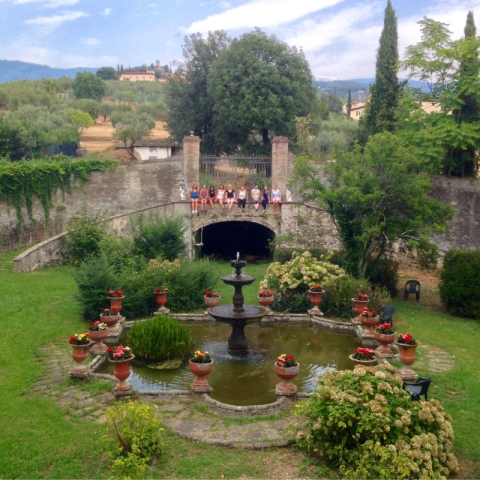 Our Villa Garden in Tuscany
Our Villa Garden in Tuscany
The fact that we are studying in Italy and Greece compels me to introduce a short conversation about ancient philosophers to my students. To make this interesting we read short synopses of seven different philosophies of the ancient world and see which of these resonates with their ideas of how to live a good life. Through a series of questions most of my students this term decided that they identified with Epicureanism. One student decided he was a nihilist, though that wasn’t on the list, and a few were drawn to Neoplatonism.
Epicurus was a 3rd BCE philosopher who believed that through elimination of fears and desires (ataraxia) people would be free to pursue simple pleasures to which they are naturally drawn. His followers were known as the Garden People and worked to banish superstition and cultivate a rational understanding of nature. Unlike many other philosophical discourses, women were allowed and urged to join his circle. Epicureans felt that discovering simple pleasures and living a prudent life leads to the greatest social happiness, that understanding the power of living within nature’s limits was essential. The word Epicureanism is misunderstood now as advocating hedonism but the philosopher himself said that a person can only be happy and free by living wisely, soberly, and morally. He said, “Nothing is enough for the man for whom enough is too little”. Our intention is to create an arts program with echos of this joyful search for individual happiness. We stress living with few material requirements, eating food prepared with pure ingredients and being in nature. We have no pretensions to luxury and yet we provide a wonderfully rich and fruitful atmosphere in which students can achieve their best . When simple wants are satisfied we have a deeper appreciation for the aesthetics aspects of life, of beauty, of art.
 Epicurus
Epicurus
In contrast to my students, I tend toward the Stoic philosophy. Again, modern understanding of this philosophy misinterprets Stoicism as merely censoring strong emotions. Marcus Aurelius and Epitectus elucidate the philosophy of Stoicism as a guide to find peace; integrity being the chief good. Epitectus said, ““Happiness and freedom begin with a clear understanding of one principle: Some things are within our control, and some things are not. It is only after you have faced up to this fundamental rule and learned to distinguish between what you can and can’t control that inner tranquility and outer effectiveness become possible.” What he believed was true education consists in recognizing that each individual has their own will and cannot be compelled or hindered by anything external. He felt that individuals are not responsible for the thoughts that arrive in their consciousnesses though they are completely responsible for the way in which they use them. “Two maxims,” Epictetus wrote, “we must ever bear in mind—that apart from the will there is nothing good or bad, and that we must not try to anticipate or to direct events, but merely to accept them with intelligence.”
 Filigree of Wildflowers on Paros
Filigree of Wildflowers on Paros
And, “Wisdom means understanding without any doubt that circumstances do not rise to meet our expectations. Events happen as they may. People behave as they will.” Finding that my ideals on how to live aligned best with the Stoics I also realised it aids my teaching; empowering me to honour each individual‘s place in the hierarchy of learning, reconfirming that competition has never been an effective teaching tool. I also recognise that what I say and what I teach will be taken by each student to mean what they interpret it to be and not always what I have said. Patience and being an attentive listener are paramount in a teacher but Stoicism also illustrates that 14 different students will have 14 different approaches to a given lesson. Each student will need specific help to elicit their best qualities. It’s not about meeting my standards as much as it is about their comprehension. And, of course, a teacher must accept that each group has its own personality. Fortunately in this group, they were mostly Epicureans by nature.
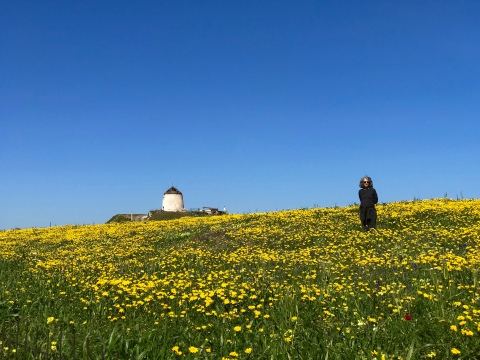 Yellow & Blue Paros Spring
Yellow & Blue Paros Spring
Tour Through Italy and Return to Greece
10, October 2016 § 2 Comments
By: Jun-Pierre Shiozawa
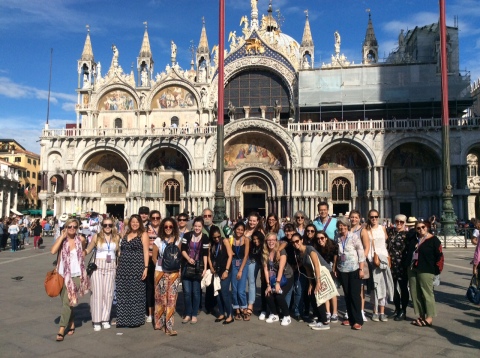
The Aegean Center in front of the Basilica of San Marco, Venice
The past month the Aegean Center for the Fine Arts marked the 28th year of its Italy program. The new group of students arrived in early September at the Villa Rospigliosi, the Aegean Center’s home in Italy. Up in the hills overlooking the Tuscan city of Pistoia, the students became accustomed to life at the Villa; classes throughout the day including drawing, photography, writing and theatre, and sharing prepared meals by the Villa chefs, who have been with the Center since the very first years.
The bulk of the Italy program involves touring the great centers of the Italian Renaissance, including Florence, Siena, Venice, Pisa, Pistoia, Rome and for the first time ever for the Aegean Center, Bologna.
In Florence, the Center was able to visit the newly reopened Museum of the Works of the Duomo featuring a new layout which recreates the facade of the Cathedral with original sculptures set in niches. We toured through the great churches and museums of Florence including the Bargello and the Uffizi. As always, the Brancacci Chapel in the church of Santa Maria del Carmine was a highlight of the tours in Florence. Inside the chapel the group was able to enjoy thirty minutes to themselves to study and admire the great fresco masterpieces of Massacio and Masolino.
On one rainy day, our bus brought us through the Tuscan hills to Siena, where we were fortunately greeted with clearer skies and sunshine. The Cathedral of Siena was less crowded than usual and we were able to admire its incredible array of sculpture and decor, its fascinating floors and the colorful Piccolimini library.
During our second week in Italy, the Aegean Center visited Venice for three days. Upon arriving, art history professor Jeffrey Carson led the tour through the Piazza San Marco and up in to the Basilica of San Marco to see the original bronze horses, taken from the hippodrome of Constantinople. The next day the Aegean Center toured the great painting museum of Venice, the Accademia and found some of our old favorites, works by Giovanni Bellini, Giorgione, and Titian.
After returning to Venice we continued our tours through Tuscany with a visit to Pisa where we enjoyed a bright sunny day in the “Piazza dei Mirocoli,” (the Plaza of Miracles) with its beautiful marble faced buildings: the Cathedral of Pisa, its baptistery, the Campo Santo and of course, the Leaning Tower. In the baptistery, Studio Arts professor Jane Pack described the innovative work of Nicola Pisano’s pulpit and we were able to hear the incredible acoustics of the baptistery interior as one of the guards made a call in to its dome which echoed with his own response.
The Aegean Center visited Bologna for the first time as well. The home of the oldest university in the world, Bologna welcomed us in its rich array of historical and religious centers, including the Basilicas of San Petronio and San Domenico. Although we were unable to see Giambologna’s Fountain of Neptune (under restoration) and Raphael’s Ectasy of St. Cecilia (currently on loan for the Pushkin Museum’s “Raphael. The Poetry of the Image” exhibition) we were taken by the austere beauty of the medieval and premedieval church complex of Santo Stefano and the energy of the city itself.
The Aegean Center students enjoyed our last meal at the Villa Rospigiliosi and thanked the Villa chefs with a thank you card and applause. Saying farewell to the Villa is always bittersweet, a mixture of sadness and excited anticipation with what lays ahead: Rome and finally Greece!
In Rome, director John Pack led the students through a winding tour of Rome’s downtown. John took the students through its famous piazzas, complete with stops for Granita di Cafe in front of the Pantheon and a trip up the Capitoline hill to view over the ancient Roman forum. The next day Jane led the group through the magical Palazzo Massimo to see its treasures including the bronze Pugilist, the dying Niobid and the lovely garden frescoes from the Villa Livia. Finally on our last day in Rome the Aegean Center woke up at the crack of dawn to visit the Vatican museum and where we had the Sistine Chapel all to ourselves, entering before any other group. We all gasped at Michelangelo’s achievements, awestruck and moved.
Rome marked the final leg of the Aegean Center’s Italian tour and the students then departed for Athens. There, under the characteristically bright Greek sunlight, art history Jeffrey Carson led the students up to the Acropolis to see the monument to the magnificence of the Ancient Athenians: The Parthenon. That night, one of the students, Aria Higgins, invited the entire Aegean Center to dine at her family restaurant, Mama Roux. The last day of touring before the students’ arrival in Paros was at the greatest museum of ancient Greek antiquities in the world, the National Archaeological Museum of Athens.
Now the students have all arrived in Paros, to settle in and prepare for the classes ahead. We are all excited to see what else will be accomplished with this close knit, energetic and talented group of students.

Sunrise over the Aegean Sea from the ferry en route to Paros
Thank you very much to Bruno-Ken Shiozawa for the use of his photographs for this post
Catching Up: First, Italy
30, January 2016 § 1 Comment
After too long a silence we are posting some past events bringing us up to the present, 2016. Like always we will try our best to stay more current…
Last September our students had the privilege to meet with Maurizio Seracini in Firenze while we were in residence at the Villa Rospigliosi in Pistoia, Italy. A passionate man whose interests range over physics, engineering and art history, he has been investigating the possibility that Leonardo da Vinci’s fresco of The Battle of Anghiari may still exist behind another later fresco on a wall in the Palazzo Vecchio in Firenze. We met him near the equestrian statue in the Piazza della Signoria and had the great honour of accompanying him to view the hall named the Salone dei Cinquecento and hear him talk on the subject. His warm and personal approach brought us all closer to the mystery of the disappearance of this masterpiece which was hailed as the greatest depiction of a battle scene at the time it was created and was copied many times before its eventual disappearance behind another fresco by Vasari. Mr. Seracini has made this search his personal quest.

Peter Paul Ruben’s copy of the lost Da Vinci masterpiece
For a more complete article on his process and work you can read this: http://www.nytimes.com/2009/10/06/science/06tier.html?pagewanted=1&_r=1&no_interstitial
Maurizio Seracini is a 1973 graduate in bioengineering from the University of California, San Diego, he founded the first company in Italy for diagnostic and non-destructive analyses on art and architecture, the Diagnostic Center for Cultural Heritage in Firenze. Adapting technologies from the medical and military fields and other technical measuring instruments he has made possible diagnostics of art and search for art without destroying the artwork itself.
In 2013, Seracini established Great Masters Art Authentication in San Diego California, the first US company dedicated to true scientific authentication of Old Masters art from the 14th to 19th Century.






